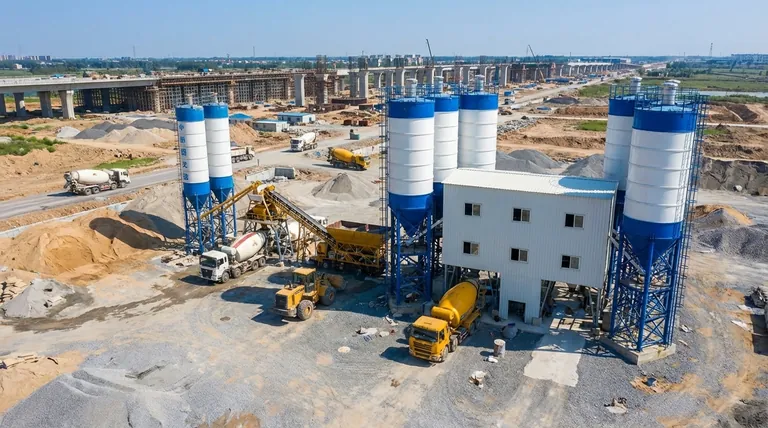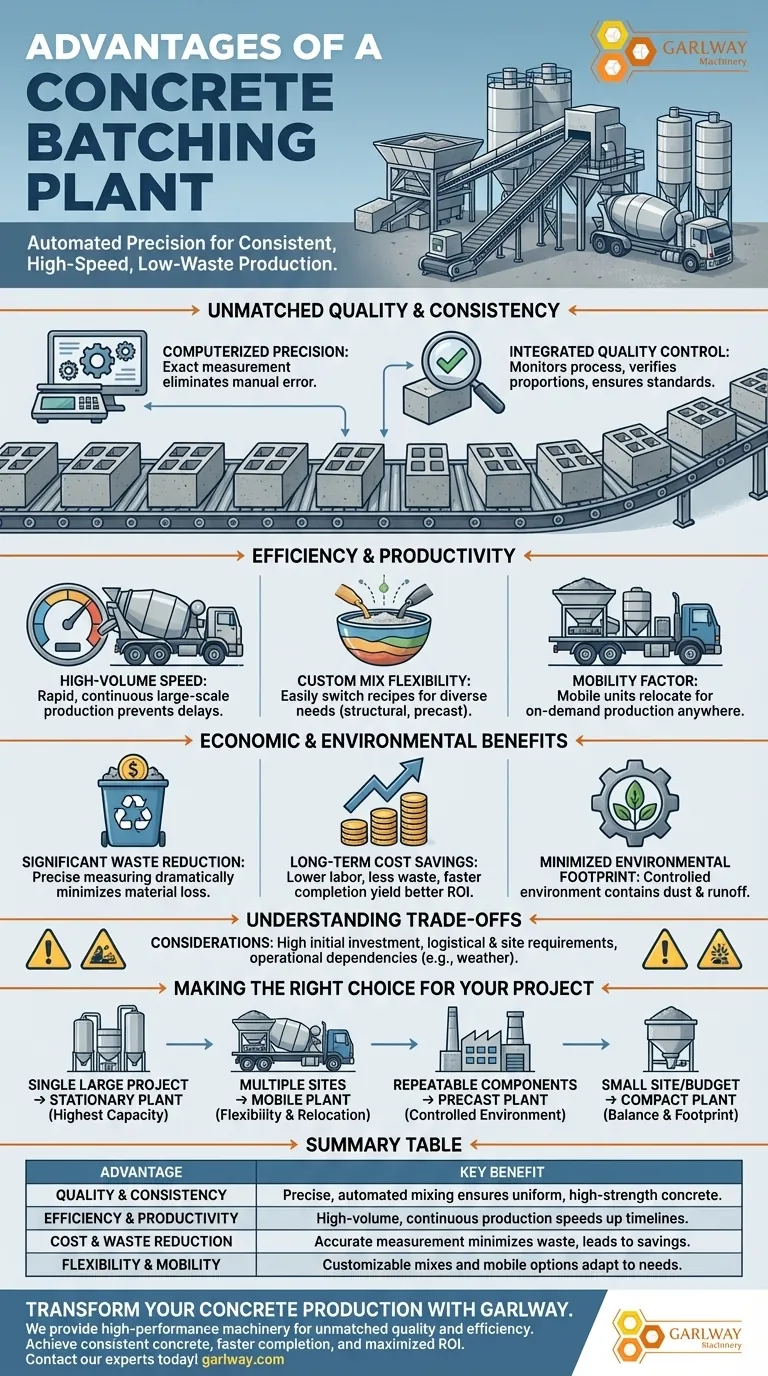The primary advantages of a concrete batching plant are its ability to produce consistently high-quality concrete at high speed while reducing material waste. These systems automate the precise measurement and mixing of ingredients—cement, aggregate, water, and admixtures—transforming concrete production from a variable craft into a reliable, industrial process.
A concrete batching plant is not merely a piece of equipment; it is a system for imposing control and predictability on one of the most critical aspects of construction. The core benefit is replacing manual error and inconsistency with automated precision, leading to higher quality, greater efficiency, and better cost management.

The Foundation: Unmatched Quality and Consistency
A batching plant’s fundamental advantage is its capacity to deliver uniform concrete, batch after batch. This reliability is the bedrock of structural integrity and project quality.
How It Achieves Uniform Mixing
A plant uses computerized systems to weigh and measure each raw material with extreme accuracy. This eliminates the guesswork and variability inherent in manual mixing, ensuring every batch meets the exact design specifications.
The Role of Integrated Quality Control
Modern plants feature automated and manual control systems that monitor the entire process. This allows operators to maintain strict quality control, verify mix proportions, and ensure the final product meets all required standards before it ever leaves the plant.
Driving Project Efficiency and Productivity
Beyond quality, batching plants are designed for speed and volume, directly impacting project timelines and operational workflow.
High-Volume, Continuous Production
Batching plants are engineered for rapid, large-scale production. Their ability to mix and discharge large volumes of concrete quickly ensures a steady supply for large pours, preventing costly delays on-site.
Customization for Diverse Needs
These plants offer significant flexibility in mix design. Operators can easily switch between different concrete recipes, producing everything from standard structural concrete to specialized mixes required for precast elements or unique architectural finishes.
The Mobility Factor
For contractors managing multiple job sites, mobile concrete batching plants are a game-changer. These units can be dismantled, transported, and reassembled at a new location, providing on-demand production exactly where it's needed.
The Economic and Environmental Case
The precision of a batching plant translates directly into financial and environmental benefits by optimizing resource use.
Significant Reduction in Material Waste
By measuring ingredients precisely, batching plants dramatically reduce the loss of raw materials. This contrasts sharply with on-site mixing, where spillage and inaccurate portioning often lead to significant waste.
Long-Term Cost Savings
While the initial investment can be high, the long-term savings are substantial. Reduced material waste, lower labor costs due to automation, and faster project completion all contribute to a more cost-effective operation.
Minimized Environmental Footprint
Less waste means a smaller environmental impact. The controlled environment of a batching plant also helps contain dust and runoff, making it a more responsible choice compared to less organized mixing methods.
Understanding the Trade-offs
To make an informed decision, it's critical to weigh the advantages against the practical considerations and potential downsides.
High Initial Investment
The most significant barrier is the upfront capital cost. A stationary batching plant is a major investment and requires careful financial planning.
Logistical and Site Requirements
Stationary plants are difficult and expensive to relocate. They require a stable site with good road access for material delivery and concrete transport, which can be a constraint in remote or congested areas.
Operational Dependencies
Production can be susceptible to external factors. For example, most plants must halt operations during heavy rain, which can impact project schedules if not properly planned for.
Making the Right Choice for Your Project
Selecting the right plant configuration depends entirely on your operational goals and project constraints.
- If your primary focus is a single, large-scale construction project: A stationary plant offers the highest production capacity and consistent quality for a dedicated site.
- If your primary focus is serving multiple, geographically separate projects: A mobile batching plant provides the flexibility to relocate your production hub efficiently.
- If your primary focus is producing high-quality, repeatable components: A precast concrete plant provides the controlled environment needed for superior product quality and speed.
- If your primary focus is a smaller site with space or budget constraints: A compact, hopper-fed plant offers a strong balance of productivity and a smaller footprint.
Ultimately, choosing the right batching plant transforms concrete production from a project variable into a predictable and controlled asset.
Summary Table:
| Advantage | Key Benefit |
|---|---|
| Quality & Consistency | Precise, automated mixing ensures uniform, high-strength concrete for every batch. |
| Efficiency & Productivity | High-volume, continuous production speeds up project timelines and reduces delays. |
| Cost & Waste Reduction | Accurate material measurement minimizes waste and leads to significant long-term savings. |
| Flexibility & Mobility | Customizable mixes and mobile options adapt to diverse project needs and locations. |
Ready to Transform Your Concrete Production?
GARLWAY specializes in providing high-performance construction machinery, including robust and efficient concrete batching plants, for construction companies and contractors globally. Our solutions are designed to deliver the unmatched quality, efficiency, and cost savings detailed above.
Let us help you achieve:
- Consistent, high-quality concrete for superior structural integrity.
- Faster project completion with high-volume, reliable production.
- Maximized ROI through reduced material waste and operational costs.
Contact our experts today to discuss your specific needs and find the perfect batching plant solution for your business.
Visual Guide

Related Products
- HZS180 Ready Mix Concrete Plant for Foundations with Sand and Cement
- HZS75 Concrete Batching Plant Cement Mixer Price Concrete Mixer Bunnings Mixing Plant
- HZS120 Ready Mix Concrete Batching Plant Commercial Mud Cement Mixer
- HZS35 Small Cement Concrete Mixing Batch Plant
- Portable Concrete Mixer Machine Equipment for Mixing Concrete
People Also Ask
- How to make ready mix concrete stronger? Boost Strength with Proven Mixing Techniques
- What are the advantages of a concrete plant? Achieve Consistent Quality & Efficiency for Large-Scale Projects
- What are the disadvantages of ready mix concrete? Navigating Logistical and Cost Challenges
- What are the different types of cement plants? A Guide to Wet Mix, Dry Mix, Stationary & Mobile Plants
- What are the advantages of ready mix concrete? Higher Quality, Efficiency & Cost Savings














